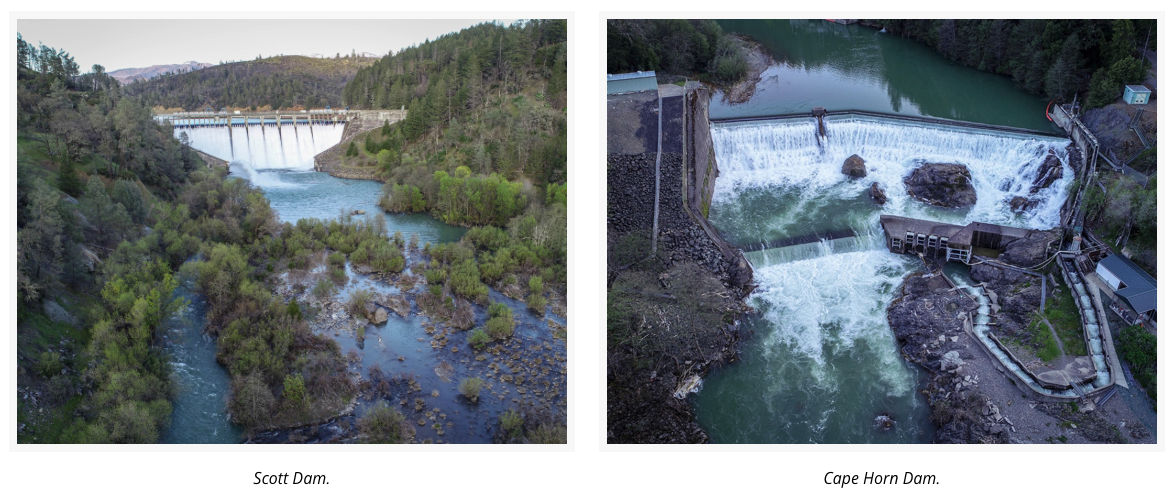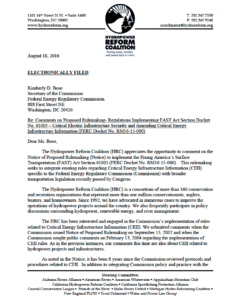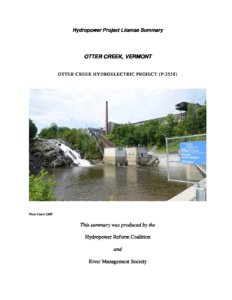Dam Removal on the Eel is Closer Than Ever

Scott Dam. Credit: EcoFlight
Water Users Support Restoring Eel River to Free-Flowing State
New proposal by Sonoma and Mendocino County water agencies, Round Valley Indian Tribes calls for dam removal and a new water diversion facility
Dam removal on the Eel River is closer than ever after county water agencies and a tribal government announced a last-minute conceptual plan for how a trans-basin water diversion from the Eel River to the Russian River watershed might be continued after the Pacific Gas & Electric Company removes two century-old dams on the upper Eel River.
The proposal was submitted to PG&E last week by the Mendocino County Inland Water and Power Commission, the Round Valley Indian Tribes, and the Sonoma County Water Agency, in response to the company’s announcement earlier this year that it intends to remove Scott and Cape Horn dams as part of its draft plan for decommissioning the Potter Valley Project, which stopped producing electricity in 2021. The dams block native salmon and steelhead from reaching prime habitat in the headwaters of the Eel, and restoring upstream and downstream fish passage past the dam sites is a high priority for federal and state fisheries agencies as well as conservationists.
PG&E has said they will submit a draft decommissioning plan to federal regulators by November of this year. In May, the company left the door open for entities interested in taking ownership of any part of the project’s facilities – including the inter-basin diversion infrastructure – and asked that proposals be submitted by the end of July. A final license surrender and decommissioning plan is due in early 2025.
California Trout and Trout Unlimited reacted to the announcement with cautious optimism. “This proposal represents progress on broader discussions between Russian River and Eel River stakeholders—two dams being removed, PG&E paying their fair share as they exit the basin, and Russian River water interests paying for water and water infrastructure associated with a diversion of Eel River water,” said CalTrout Executive Director Curtis Knight. “We will continue to engage in a collaborative and inclusive process to work out the details and address deficiencies in this proposal.”
“It’s good to see these parties put forward a proposal, but it remains to be seen how much it actually changes anything, said Matt Clifford, California Director of Law and Policy for Trout Unlimited. “The high-level goals – ensuring unobstructed fish passage past the former dam sites while allowing for continued water diversion at levels consistent with fish recovery on the Eel – are things we have supported for years. The hard part has always been coming to agreement on the specifics – how much water will be diverted, and when, and using what infrastructure, and who pays for it. This proposal punts resolution of those issues to the future. We look forward to continuing constructive discussions, but there’s a lot of work left to do – and in light of the dam removal timeline, not a lot of time left to do it.”
Many important details remain unclear in the proposal, including a final design for the diversion structure, timing and rate of diversions, how diversions might impact the Eel River, and who would be responsible for the substantial cost of constructing the new diversion facilities and of operating and maintaining them over time.
“This proposal signals that Russian River water users recognize there cannot be an ongoing water diversion without prioritizing the recovery of the Eel River watershed,” said Darren Mierau, North Coast Director for CalTrout. “Today’s announcement makes clear that a free-flowing Eel River is all but guaranteed in the years to come. That’s good news for salmon given the dire straits facing this keystone species, but we must act with urgency to restore California’s largest free flowing river to give these species a chance.”
Background: About the Potter Valley Project
Located on the Eel River 20 miles northeast of Ukiah, Scott and Cape Horn Dam are more than 100 years old. Equipment failures in 2021 caused project owner PG&E to permanently suspend hydropower operations. The dams are seismically unsound and completely block fish passage to high quality cold-water habitat in the Eel River headwaters.
The Potter Valley Project includes two Eel River dams, a diversion tunnel that moves water out of the Eel River watershed and into the East Branch of the Russian River, and a powerhouse. The Project’s owner, PG&E, has allowed its license for the operation to expire and is currently working with federal regulators to develop a decommissioning plan for the facilities. PG&E has informed stakeholders that they intend to remove all in-water facilities as part of decommissioning.
Removing the Potter Valley Project’s dams would make the Eel River California’s longest free flowing river and would reconnect salmon and steelhead with almost 300 miles of habitat in the upper mainstem Eel River. Scientists recognize the Eel River as having the potential to support the rebound of these fisheries throughout the North Coast region.
Conservation and commercial fishing groups have long advocated for a free-flowing Eel River. In 2023, American Rivers named the Eel one of America’s Most Endangered Rivers, citing the Potter Valley Project dams as major factors driving Chinook salmon, steelhead, and Pacific lamprey toward extinction.

The post Dam Removal on the Eel is Closer Than Ever appeared first on California Trout.


